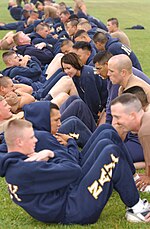Sit-up

Thesit-up(orcurl-up) is an abdominal endurance training exercise to strengthen, tighten and tone theabdominal muscles.It is similar to acrunch(crunches target therectus abdominisand also work theexternalandinternal obliques), but sit-ups have a fuller range of motion and condition additional muscles.
Form
[edit]Sit-ups begin with the practicing individual lying with their back on the floor. Typically, this is done with the arms across the chest or hands behind the head. The knees and toes are bent to reduce stress on the back muscles and spine. Both the upper and lowervertebraeare elevated from the floor until everything superior to thebuttocksis not touching the ground. Some[who?]argue that sit-ups can be dangerous due to high compressive lumbar load[1][unreliable medical source?]and may be replaced with thecrunchin exercise programs.[2]Performing alternative abdominal exercises to sit-ups actually increases the ability to do sit-ups.[3]
Performing sit-ups do not cause thespot reductionof fat at the waist.[4] Gaining a "six pack"requires both abdominalmuscle hypertrophytraining and fat loss over the abdomen—which can only be done by losing fat from the body as a whole.[citation needed]
Variations
[edit]
The movement can be made easier by placing the arms further down away from the head. Typical variations to this include crossing the arms to place the palms on the front of the shoulders[5]and extending the arms down to the sides with palms on the floor.[6]The 'arms on shoulders' variation is also used to make the incline sit-up[7]easier.
More intense movement is achieved by doing weighted sit-ups,[8]incline sit-ups with arms behind neck[9]and even harder by doing the weighted incline sit-up.[10]
Health risks
[edit]With improper form, full sit-ups have been found to cause back pain and arching of the lower back, increasing the risk ofback injury.[11]
In 2015, it was revealed that every branch of the U.S. armed forces have begun to phase out sit-ups andcrunches,due to the high rates of lower-back injury. They have been replaced byplanks.[12]
See also
[edit]References
[edit]- ^McGill, Stuart M. (June 1999)."Stability: from biomechanical concept to chiropractic practice".Journal of the Canadian Chiropractic Association.43(2): 75–88.PMC2485366.
- ^McGill, Stuart (2002).Low Back Disorders: Evidence-based Prevention and Rehabilitation.Human Kinetics Publishers.ISBN978-0-7360-6692-1.[page needed]
- ^Childs, John D.; Teyhen, Deydre S.; Benedict, Timothy M.; Morris, Jamie B.; Fortenberry, Andrew D.; McQueen, Rene M.; Preston, Janice B.; Wright, Alison C.; Dugan, Jessica L.; George, Steven Z. (2009)."Effects of Sit-up Training versus Core Stabilization Exercises on Sit-up Performance".Medicine & Science in Sports & Exercise.41(11): 2072–2083.doi:10.1249/MSS.0b013e3181a84db2.PMID19812508.
- ^Katch, Frank I.; Clarkson, P. M.; Kroll, W.; McBride, T.; Wilcox, A. (September 1984)."Effects of sit up exercise training on adipose cell size and adiposity".Research Quarterly for Exercise and Sport.55(3): 242–47.doi:10.1080/02701367.1984.10609359.
- ^"Sit-up (arms crossed)".Retrieved20 November2014.
- ^"Sit-up (arms down)".Retrieved20 November2014.
- ^"Incline Sit-up (arms crossed)(2qqa)".Retrieved20 November2014.
- ^"Weighted Sit-up".Retrieved20 November2014.
- ^"Incline Sit-up".Retrieved20 November2014.
- ^"Weighted Incline Sit-up (arms crossed)".Retrieved20 November2014.
- ^Abdominal Training
- ^Mull, Amanda (28 May 2022)."The Sit-Up is over".The Atlantic.Retrieved31 May2022.
